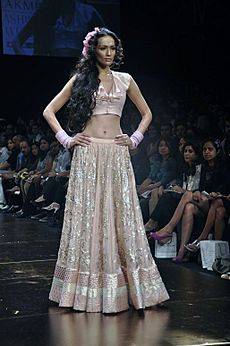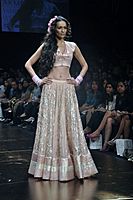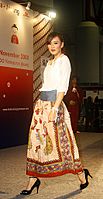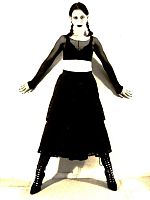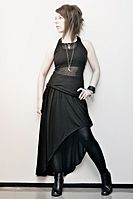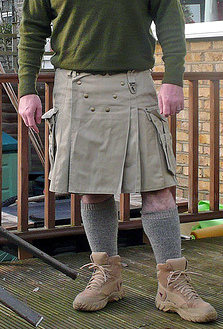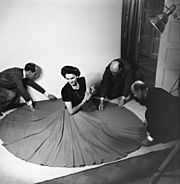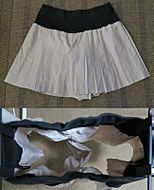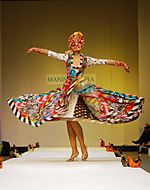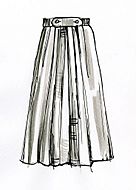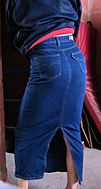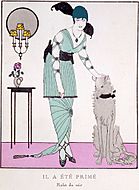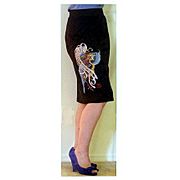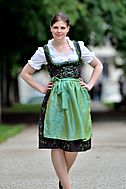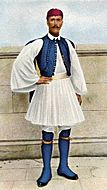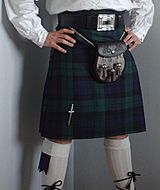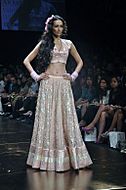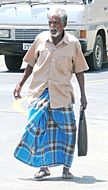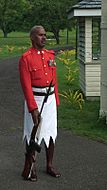Skirt facts for kids
A skirt is a piece of clothing that hangs downwards from the waist. Different skirts have been worn in many different cultures at different times. There are skirts that are clothing for women, for men, or for both.
In modern Western / European culture skirts are usually worn by women. An exception is the kilt and the fustanella, which are traditional skirts for men that are still worn today.
Skirts are worn at semi-formal occasions, and sometimes at formal events, although a dress is more common.
Contents
Basic types
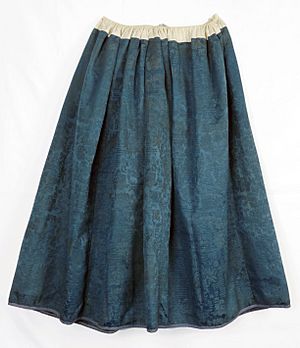
- A-line skirt, a skirt with a slight flare, roughly in the shape of a capital letter A
- Bell-shaped skirt, flared noticeably from the waist but then, unlike a church bell, cylindrical for much of its length
- Circle skirt, a skirt cut in sections to make one or more circles with a hole for the waist, so the skirt is very full but hangs smoothly from the waist without darts, pleats, or gathers
- Culottes, a form of divided skirt, split skirt or pantskirt constructed like a pair of shorts, but hanging like a skirt.
- Divided skirt, see under: Culottes.
- Full skirt, a skirt with fullness gathered into the waistband
- Gored skirt, a skirt that fits through the waistline and flares at the hem. May be made of from four to twenty-four shaped sections. Dates from the 14th century and much used in the 19th century. Very popular in the late 1860s, mid-1890s, early 20th century, 1930s, 1940s, and now worn as a classic skirt style.
- Inverted pleated skirt, a skirt made by bringing two folds of fabric to a center line in front and/ or back. May be cut straight at sides or be slightly flared. Has been a basic type of skirt since the 1920s.
- Pencil skirt, see under: Straight skirt.
- Pleated skirt, a skirt with fullness reduced to fit the waist by means of regular pleats ('plaits') or folds, which can be stitched flat to hip-level or free-hanging
- Short skirt, a skirt with hemline above the knee
- Straight skirt or Pencil skirt, a tailored skirt hanging straight from the hips and fitted from the waist to the hips by means of darts or a yoke; may have a vent or kick-pleat set in the hem for ease of walking
- Underskirt, simple, basic skirt over which an overskirt, or drapery, hangs.
- Wrap or wraparound skirt, a skirt that wraps around the waist with an overlap of material
Fads and fashions
- Ballerina skirt, a mid-calf full skirt popular in the 1950s.
- Broomstick skirt, a light-weight ankle-length skirt with many crumpled pleats formed by compressing and twisting the garment while wet, such as around a broomstick. (1980s and on)
- Bubble dress/skirt, (also called tulip skirt or balloon skirt) a voluminous skirt whose hem is tucked back under to create a “bubble effect” at the bottom. Popular in the 1950s.
- Cargo skirt, a plain utilitarian skirt with belt loops and numerous large pockets, based on the military style of Cargo pants and popularised in the 1990s.
- Crinoline, a very full skirt supported by hoops or multiple petticoats, popular at various times from the mid 19th century onwards.
- Dirndl skirt, (durn′del) a skirt in the Bavarian-Austrian dirndl style, made of a straight length of fabric gathered at the waist. The style derives from Tyrolean peasant costume.
- Denim skirt (or jeans skirt), a skirt made of denim, often designed like 5-pocket jeans, but found in a large variety of styles.
- Godet skirt, (go-day’), a skirt with triangular pieces of fabric inserted upward from the hem to give more fullness. Popular in the 1930s.
- Hobble skirt, a long and tight skirt with a hem narrow enough to significantly impede the wearer's stride
- Kilt-skirt, a wrap-around skirt with overlapping aprons in front and pleated around the back. Though traditionally designed as women's wear, it is fashioned to mimic the general appearance of a man's kilt.
- Leather skirt, a skirt made of leather
- Lehenga (also Ghagra; Garara ), a long, pleated skirt, often embroidered, worn mostly as the bottom part of the Gagra choli in North India and Pakistan.
- Maxi skirt, an ankle-length daytime skirt, popular with women in the late 1960s as reaction against miniskirts.
- Micromini, an extremely short miniskirt.
- Midi skirt, skirt with hem halfway between ankle and knee, below the widest part of the calf. Introduced by designers in 1967 as a reaction to very short mini skirts.
- Mini-crini, a mini-length version of the crinoline, designed by Vivienne Westwood in the mid 1980s.
- Poodle skirt, a circle or near-circle skirt with an appliqued poodle or other decoration (1950s)
- Puffball skirt (also called "puff" or "pouf"), a bouffant skirt caught in at the hem to create a puffed silhouette. Popular in the mid-late 1980s when it was inspired by Westwood's "mini-crini".
- Rah-rah skirt, a short, tiered, and often colourful skirt fashionable in the early-mid-1980s.
- Sarong, a square or rectangle of fabric wrapped around the body and tied on one hip to create a skirt that can be worn by both sexes
- Scooter skirt or skort (variant), a skirt that has an attached pair of shorts underneath for modesty. Alternatively, but with similar effect, a pair of shorts incorporating a skirt-like flap across the front of the body.
- Skater skirt, a short, high-waisted circle skirt with a hemline above the knee, often made of lighter materials to give the flowing effect that mimics the skirts of figure skaters.
- Squaw dress or fiesta dress, a one or two piece outfit based on Native American clothing. Fashionable in the 1940s and 50s.
- Swing skirt, flared skirt, circular or cut in gores, fitted at hips with a wide flare at the hem. Popular in the late 1930s and at interval since. Very popular in the mid-1980s.
- T-skirt, made from a tee-shirt, the T-skirt is generally modified to result in a pencil skirt, with invisible zippers, full length two-way separating side zippers, as well as artful fabric overlays and yokes.
- Tiered skirt, made of several horizontal layers, each wider than the one above, and divided by stitching. Layers may look identical in solid-colored garments, or may differ when made of printed fabrics.
- Prairie skirt (variant), a flared skirt with one or more flounces or tiers (1970s and on)
- Trouser skirt or cullotte, a straight skirt with the part above the hips tailored like men's trousers, with belt loops, pockets, and fly front.
- Tulip skirt, see under: Bubble skirt.
Lengths
-
Miniskirt, a skirt ending between knee and upper thigh. (1960s onwards)
-
Microskirt, an extremely short miniskirt.
Male wear
There are a number of garments marketed to men which fall under the category of "skirt" or "dress". These go by a variety of names and form part of the traditional dress for men from various cultures. Usage varies – the dhoti is part of everyday dress on the Indian subcontinent while the kilt is more usually restricted to occasional wear and the fustanella is used almost exclusively as costume. Robes, which are a type of dress for men, have existed in many cultures, including the Japanese kimono, the Chinese cheongsam, the Arabic thobe, and the African Senegalese kaftan. Robes are also used in some religious orders, such as the cassock in Christianity and various robes and cloaks that may be used in pagan rituals. Examples of men's skirts and skirt-like garments from various cultures include:
- The fustanella is a full-pleated skirt worn by men in Albania and Greece and other parts of the Balkans. By the mid-20th Century, it was relegated to ceremonial use and as period or traditional costume. It is worn by the Evzones, or Evzoni (Greek: Εύζωνες, Εύζωνοι, pronounced [evˈzones, evˈzoni]), which is the name of several historical elite light infantry and mountain units of the Greek Army. Today, it refers to the members of the Presidential Guard who parade the presidential mansion wearing a short version of this historic costume.
- The gho is a knee-length robe worn by men in Bhutan. They are required to wear it every day as part of national dress in government offices, in schools and on formal occasions.
- The hakama is worn in Japan. There are two types of hakama, divided umanori (馬乗り, "horse-riding hakama") and undivided andon hakama (行灯袴, "lantern hakama"). The umanori type has wide and divided legs, similar to culottes. Some hakamas are pleated.
- The kilt is a skirt of Gaelic and Celtic history, part of the Scottish national dress in particular, and is worn formally and to a lesser extent informally. Irish and Welsh kilts also exist but are not so much a part of national identity.
- The sarong is a piece of cloth that may be wrapped around the waist to form a skirt-like garment. Sarongs exist in various cultures under various names, including the pareo and lavalava of the Hawaiian islands and Polynesia (Samoa, Tonga, Tahiti, and Fiji), the Indian dhoti and lungi, and the South Indian and Maldivian mundu.
Aside from the wearing of kilts, in the Western world skirts, dresses, and similar garments are generally viewed exclusively women's clothing which, historically, was not always the case. However, Western men have taken up skirts as forms of civil protest. Other Western men advocate skirts as a measure of co-equality between women and men.
Gallery
- Basic types
- Fads and fashions
- World culture
Related pages
Images for kids
-
Drawing of a girl's skirt made of wool yarn found in a Bronze Age tomb in Borum Eshøj (Danmark)
See also
 In Spanish: Falda para niños
In Spanish: Falda para niños


